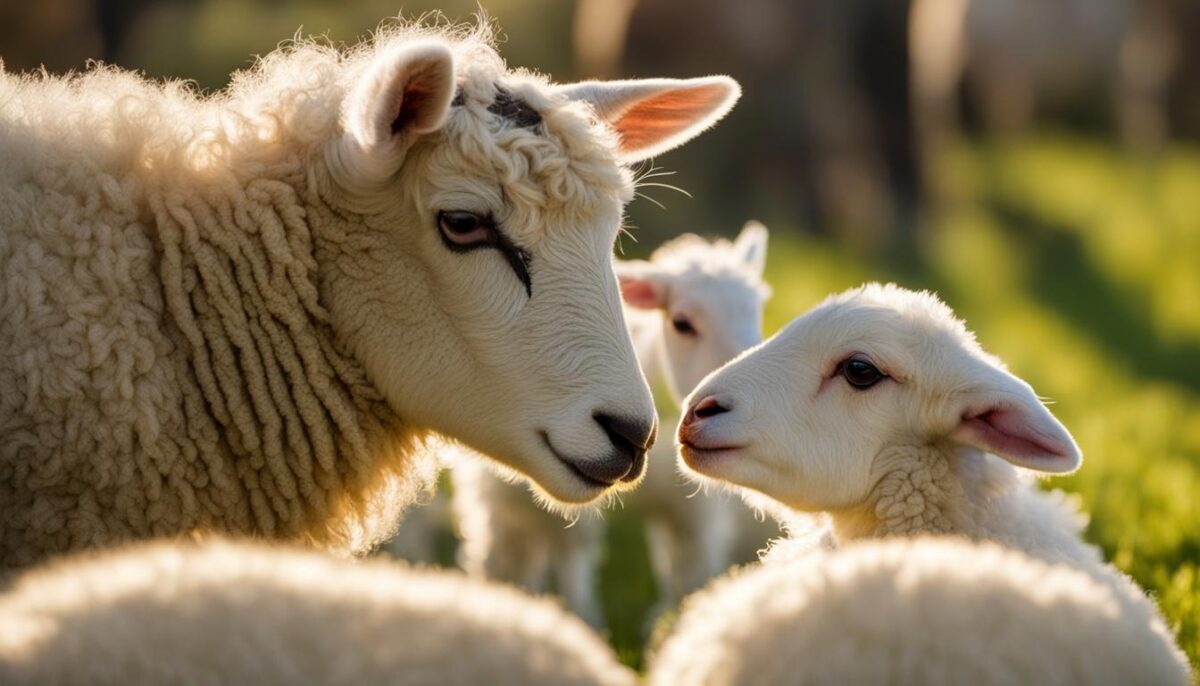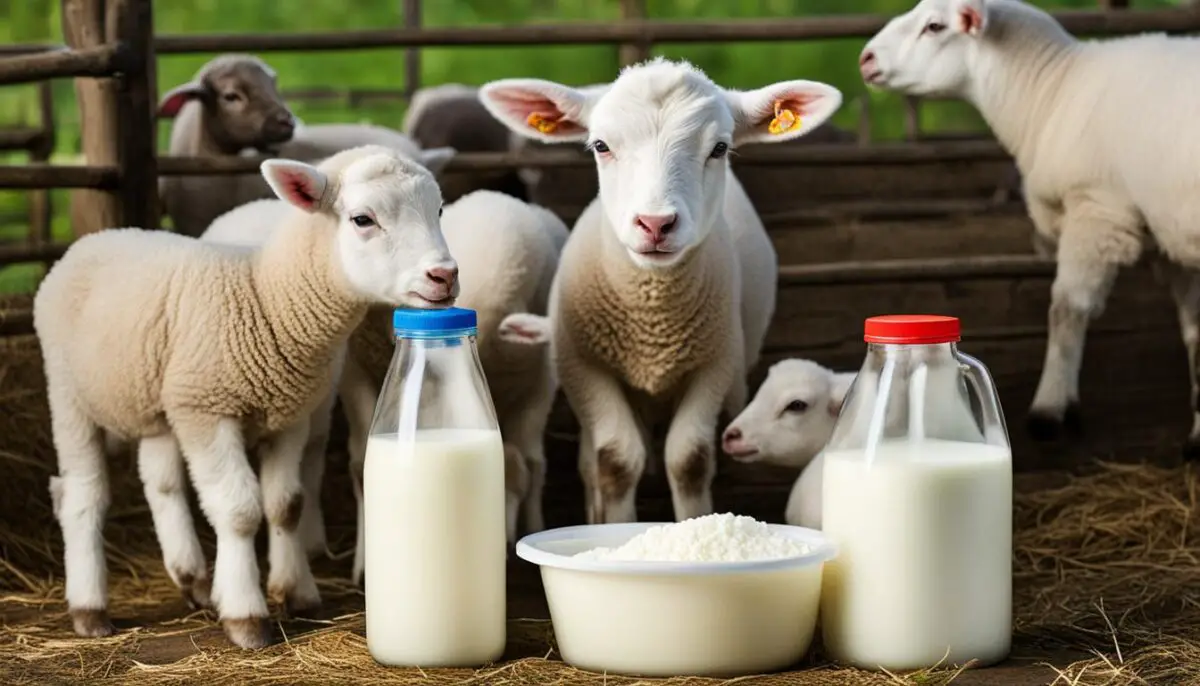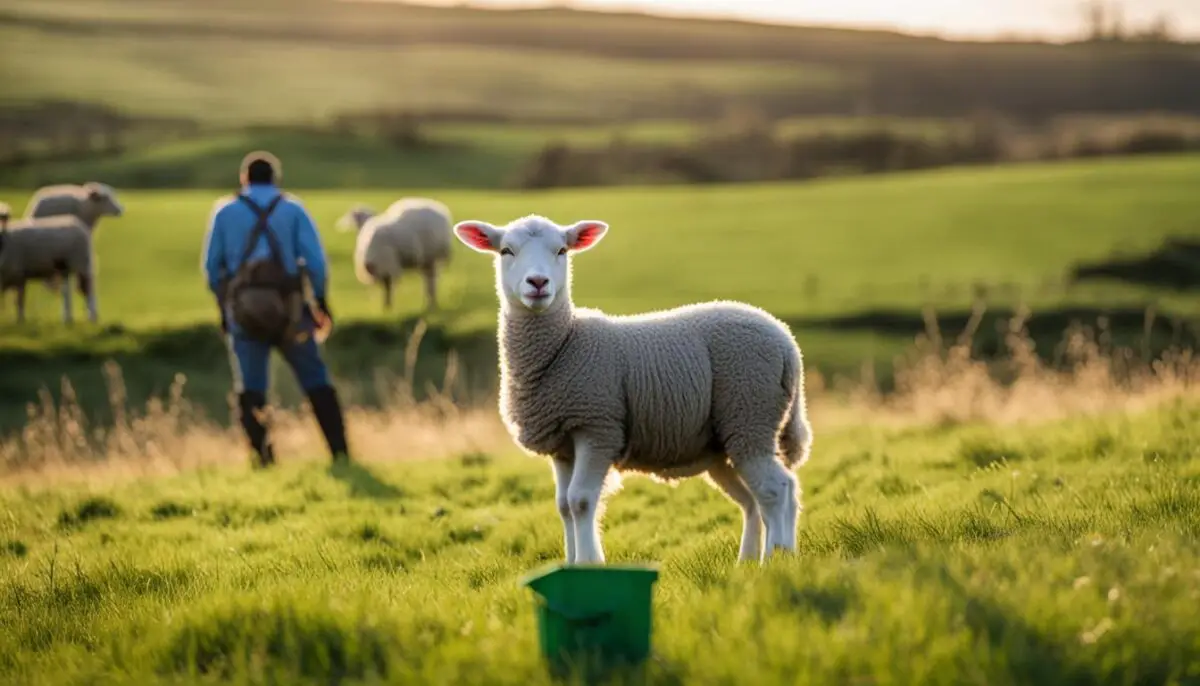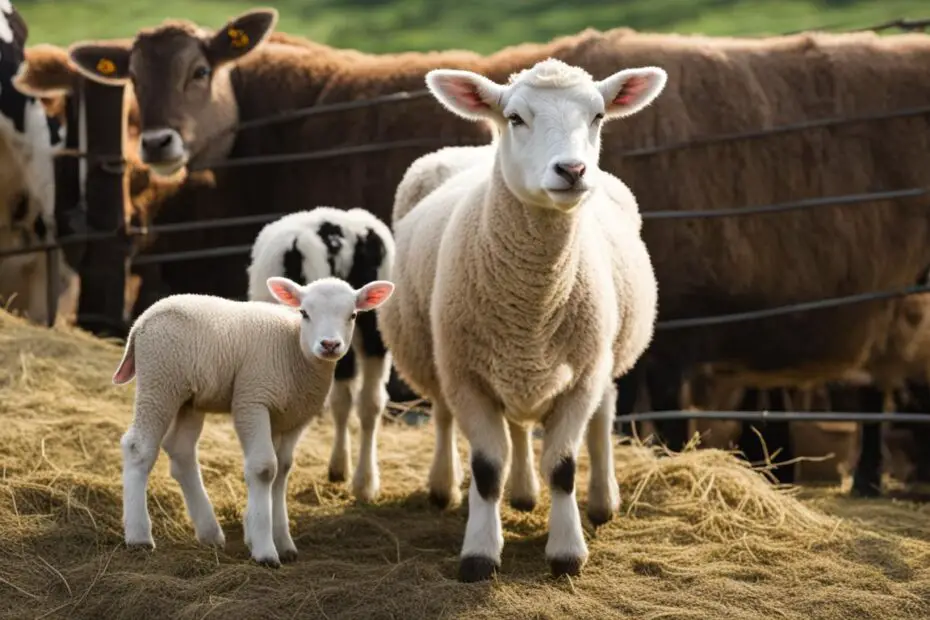When caring for lambs, it’s important to understand their feeding options and whether they can consume cows milk. Lambs may require bottle feeding in certain situations, such as when they are sick, abandoned, or orphaned. Learning how to bottle feed a lamb is a crucial skill for sheep producers. In this comprehensive guide, we will explore the different feeding options for lambs and whether cows milk is safe for them to consume.
Key Takeaways:
- Lambs may need to be bottle fed if they are sick, abandoned, or orphaned.
- Choosing the right bottle and nipple is important for successful bottle feeding.
- Powdered milk replacer and whole cows milk are common options for feeding lambs.
- Grafting a bottle baby lamb onto a ewe can be a successful bonding process.
- Feeding schedules and gradually weaning bottle-fed lambs are important for their development.
Why Would You Need to Know How to Bottle Feed a Lamb?
Bottle feeding a lamb is an essential skill for sheep producers, especially when encountering unpredictable lambing situations. There are various reasons why you might need to know how to bottle feed a lamb, including when the mother refuses to bond with the lamb, the lamb becomes cold and hypothermic, the mother does not produce enough milk, or the mother dies during labor. Being prepared to bottle feed a lamb can greatly increase its chances of survival in these circumstances.
Feeding lambs is a critical aspect of raising hair sheep and ensuring their well-being. Unpredictable lambing situations can arise, and having the knowledge and ability to provide nourishment through bottle feeding is crucial. When the mother rejects the lamb or is unable to produce enough milk, the lamb faces the risk of malnutrition and other health issues. Additionally, if a lamb becomes cold and hypothermic, bottle feeding can help warm them up and restore their body temperature.
In unfortunate situations where the mother dies during labor, bottle feeding is the only option to ensure the lamb’s survival. Without intervention, the lamb would not receive the necessary nutrients and care required for healthy growth. Knowing how to bottle feed a lamb allows for immediate intervention, providing the lamb with the nourishment it needs to thrive.
What Bottle to Use and Different Options for Milk
When it comes to bottle feeding lambs, choosing the right bottle and nipple is important. Many sheep producers recommend using red Pritchard Nipples as they closely resemble a teat and are suitable for newborn lambs. These nipples allow the lambs to easily suckle and mimic the natural feeding process.
In terms of milk options, there are several choices available. Powdered milk replacer is a common option and should be milk-based rather than soy-based. It is important to follow the instructions on the packaging and mix it with warm water according to the recommended ratio.
Another option for feeding lambs is whole cows milk. Both pasteurized and raw cows milk can be used, although raw milk may carry a higher risk of bacterial contamination. If using raw milk, it is crucial to ensure its quality and safety. Farmers who have their own dairy cows may choose to use their own milk for feeding the lambs.
Some sheep producers may prefer homemade milk replacer recipes, which allow for a more customized option. These recipes often include a combination of ingredients such as condensed milk, egg yolks, and vegetable oil. It is important to note that homemade milk replacers may require additional supplementation to ensure the lambs receive all necessary nutrients.
Table: Comparison of Milk Options for Lambs
| Milk Option | Advantages | Considerations |
|---|---|---|
| Powdered Milk Replacer | – Specifically formulated for lambs | – Follow instructions on packaging for correct mixing – Ensure milk replacer is milk-based, not soy-based |
| Whole Cows Milk | – Easily accessible and commonly used | – Pasteurized milk is recommended to reduce the risk of bacterial contamination – Raw milk may require additional safety measures |
| Homemade Milk Replacer | – Customizable recipe options | – May require additional supplementation to meet nutritional needs – Requires knowledge of ingredient ratios and nutritional balance |
Choosing the right bottle and milk option is essential for the health and growth of bottle-fed lambs. It is recommended to consult with experienced sheep producers or veterinarians for guidance on the best feeding practices and to ensure that the lambs are receiving adequate nutrition.
Grafting a Bottle Baby onto a Ewe
In some cases, it may be possible to graft a bottle baby lamb onto a ewe that has lost her own lamb. This process involves using the skin from a dead lamb and tying it onto the bottle baby to initiate the bonding process. Grafting a bottle baby onto a ewe can be a successful way to ensure the lamb is raised by a mother instead of relying solely on bottle feeding. However, it is essential to follow the proper skinning and tying process to increase the chances of successful grafting with sheep.
During the grafting process, the skin from the dead lamb is carefully removed and tied onto the bottle baby. The ewe is then introduced to the lamb, allowing her to smell the familiar scent of her own lamb on the bottle baby. This can help stimulate the ewe’s maternal instincts and increase the likelihood of her accepting and nurturing the graft lamb.
“Grafting can be a challenging process that requires expertise and careful execution. It is recommended to consult with experienced producers or veterinarians who have successfully performed grafting before attempting it yourself.”
Successful grafting not only allows the lamb to be raised by a mother, but it also provides socialization and natural behaviors that are crucial for their overall well-being. It is important to note that the process of grafting can vary, and each situation may require individualized care and attention. With proper guidance and patience, grafting a bottle baby onto a ewe can be a beneficial option for the lamb’s growth and development.
Table: Steps for Grafting a Bottle Baby onto a Ewe
| Step | Description |
|---|---|
| 1 | Skinning the dead lamb: Carefully remove the skin from the deceased lamb, taking care not to damage it. |
| 2 | Tying the skin onto the bottle baby: Securely tie the skin onto the bottle baby, ensuring it is snug and properly positioned. |
| 3 | Introducing the bottle baby to the ewe: Allow the ewe to smell and interact with the bottle baby, gradually introducing them and monitoring their reactions. |
| 4 | Supporting the bonding process: Provide continuous support and observation to ensure the ewe accepts the graft lamb and nurtures it as her own. |
While grafting a bottle baby onto a ewe can be a complex process, it offers a valuable opportunity for the lamb to experience natural maternal care and socialization. It is crucial to approach grafting with caution and seek guidance from experienced individuals to increase the chances of success.

How Much to Feed a Lamb
Feeding lambs the appropriate amount of milk is crucial for their growth and development. The quantity of milk required will vary based on the lamb’s age and weight. Generally, lambs should be fed around 20% of their body weight in milk. It is important to follow feeding recommendations and adjust as the lamb grows.
For newborn lambs that are 1-2 days old, they should be fed 4-6 ounces of milk four times a day. As they grow older, the milk intake can be gradually reduced. This allows them to transition to solid feed and eventually be weaned off milk entirely. It is recommended to wean bottle-fed lambs over a two-week period to ensure a smooth transition.
Here is a feeding schedule for bottle lambs based on age:
| Age (in days) | Milk Intake (ounces) | Number of Feedings per day |
|---|---|---|
| 1-2 | 4-6 | 4 |
| 3-7 | 8-12 | 3 |
| 8-14 | 12-16 | 3 |
| 15-21 | 16-20 | 2 |
| 22+ | Weaning process | Gradual reduction |
It’s important to monitor the lamb’s growth and adjust the feeding schedule accordingly. Every lamb is unique, and their nutritional needs may vary. However, following these general guidelines can help ensure that lambs receive the appropriate amount of milk for their development.
Dealing with Stubborn Lambs
Feeding difficulties can arise when bottle-feeding lambs, especially if they have previously nursed from their mother. However, with the right strategies and techniques, it is possible to encourage stubborn lambs to take a bottle. Persistence and proper hand placement during feeding are key to success.
When dealing with a stubborn lamb, it is important to be firm yet gentle. Start by positioning yourself in a quiet and calm environment. Place one hand under the lamb’s chin, supporting its head, and use the other hand to hold the bottle. Gently guide the lamb’s mouth towards the nipple, offering the bottle at a slight angle to mimic nursing.
Offering breaks during the feeding process can also help the lamb adjust to bottle feeding. Allow the lamb to rest and process the milk before attempting to feed again. This can help them become more comfortable with the bottle and reduce any initial resistance.
Remember, each lamb is unique, and it may take time for them to adapt to bottle feeding. Patience and persistence are crucial. As you continue to work with the lamb, they will gradually become more accustomed to the bottle and develop a feeding routine.
Strategies for Encouraging Lambs to Take a Bottle:
- Be firm yet gentle when guiding the lamb’s mouth towards the nipple.
- Position yourself in a quiet and calm environment for feeding.
- Offer breaks during the feeding process to help the lamb adjust.
- Provide consistent and persistent feeding routines.
Nutritional Care for Lambs
Proper nutritional care plays a vital role in ensuring the health and development of lambs. One crucial aspect of their early nutrition is colostrum, the first milk produced by their mother. Colostrum contains essential nutrients and immunoglobulins that are crucial for the lamb’s immune system development. It is important to ensure that lambs receive colostrum within the first few hours of birth to maximize its benefits. However, if colostrum is not available, colostrum replacer can be used as an alternative.
As lambs grow older, their nutritional needs change. There are various milk options that can be introduced to lambs after the colostrum phase. Powdered milk replacer is a common choice, as it provides a balanced nutrition profile. Whole cows milk, both pasteurized and raw, can also be used as an alternative. Homemade milk replacers are an option for those who prefer a more customized approach. It is important to monitor the lamb’s stools to ensure that their digestion is functioning properly and that they are receiving adequate nutrition.
As lambs continue to grow, introducing grazing into their diet becomes essential. Grazing allows lambs to access fresh grass and other forage, which provides additional nutrients and promotes healthy development. It is important to introduce grazing gradually, allowing lambs to adjust to the new food source. Monitoring their intake and ensuring that they have access to clean water is crucial during this transition.

Providing proper nutritional care for lambs is essential for their overall well-being. From the crucial colostrum phase to the introduction of different milk options and grazing, it is important to prioritize their nutritional needs. By ensuring that lambs receive the necessary nutrients at each stage of their development, we can help them grow into healthy adult sheep.
Immediate Treatment and Monitoring for Health Issues
Monitoring the health of lambs is crucial to ensure their well-being and early detection of any potential issues. Regular rectal temperature checks are an effective way to evaluate a lamb’s health status. By gently inserting a lubricated thermometer into the lamb’s rectum, you can obtain an accurate reading of its core body temperature. A normal rectal temperature for a healthy lamb ranges between 100.4°F (38°C) and 102.2°F (39°C). Any variations from this range may indicate a potential illness or infection that requires prompt attention.
In addition to rectal temperature checks, it’s important to care for the lamb’s umbilical cord and navel area. After birth, the umbilical cord should be clean, dry, and free from any signs of infection. Keeping the area clean can help prevent the entry of bacteria and minimize the risk of navel or joint ill, which can be life-threatening for lambs. If you notice any redness, swelling, discharge, or a foul odor around the umbilical cord, it’s crucial to seek immediate veterinary assistance for proper diagnosis and treatment.
“Regular rectal temperature checks and thorough care of the lamb’s umbilical cord and navel area are essential practices in ensuring the health and well-being of lambs. Prompt treatment of any abnormalities or signs of illness is crucial to prevent further complications and potential fatality.”
When it comes to navel or joint ill, early intervention is key. If a lamb shows signs of swelling, lameness, pain, or fever, it may indicate the presence of an infection. Navel or joint ill can be caused by bacterial invasion through the umbilical cord or joints, leading to inflammation and significant health risks. It is vital to seek veterinary advice promptly, as treatment may involve the administration of antibiotics or other appropriate interventions to combat the infection and minimize the potential long-term consequences for the lamb’s health.
By diligently monitoring your lamb’s health, conducting rectal temperature checks, and providing proper care for the umbilical cord and navel area, you can enhance their chances of thriving and growing into healthy adult sheep. Remember, early detection and prompt treatment are vital in ensuring the well-being of your lambs and promoting their overall growth and development.

Conclusion
Caring for lambs and understanding their feeding options is essential for their growth and development. While lambs can drink cows milk in certain situations, such as when their mother is unable to provide sufficient milk or has rejected the lamb, it is important to follow proper feeding guidelines and monitor their health.
Bottle feeding lambs requires patience, persistence, and knowledge of their nutritional needs. It’s crucial to choose the right bottle and nipple, such as the recommended red Pritchard Nipples, and select the appropriate milk option, whether it’s powdered milk replacer, whole cows milk, or homemade milk replacer.
By providing appropriate care and feeding options, lambs can thrive and grow into healthy adult sheep. Regular monitoring of their health, including rectal temperature checks and care for the umbilical cord and navel, is vital. Any signs of illness, such as navel or joint ill, should be promptly treated by a veterinarian to ensure the well-being of the lambs.
FAQ
Can lambs drink cows milk?
Lambs can drink cows milk in certain situations, such as when they are sick, abandoned, or orphaned. However, it is important to choose the right milk option and follow proper feeding guidelines.
Why would you need to know how to bottle feed a lamb?
There are various reasons why you might need to know how to bottle feed a lamb, including when the mother refuses to bond with the lamb, the lamb becomes cold and hypothermic, the mother does not produce enough milk, or the mother dies during labor.
What bottle to use and different options for milk?
Many sheep producers recommend using red Pritchard Nipples for bottle feeding lambs. In terms of milk options, powdered milk replacer, whole cows milk, or homemade milk replacer can be used.
Is it possible to graft a bottle baby onto a ewe?
Yes, it is possible to graft a bottle baby lamb onto a ewe that has lost her own lamb. This process involves skinning the dead lamb and tying it onto the bottle baby to initiate the bonding process.
How much should I feed a lamb?
The amount of milk to feed a lamb depends on its age and weight. Typically, lambs should be fed approximately 20% of their body weight in milk. Feeding recommendations vary based on the lamb’s age and gradually reduce as they transition to solid feed.
How can I deal with stubborn lambs during bottle feeding?
It is important to be firm yet gentle when encouraging a stubborn lamb to eat from a bottle. Proper hand placement and offering breaks during the feeding process can help the lamb adjust to bottle feeding.
What is the nutritional care needed for lambs?
Colostrum, the first milk produced by their mother, is crucial for providing essential nutrients and immunoglobulins. After the initial colostrum feeding, lambs can be transitioned to different milk options. Monitoring their stools and introducing grazing as they grow older helps with their nutritional needs.
How should I monitor the health of lambs?
Regular rectal temperature checks and checking the umbilical cord and navel area are important for monitoring lamb’s health. Any signs of navel or joint ill should be immediately addressed by a veterinarian for prompt treatment.


